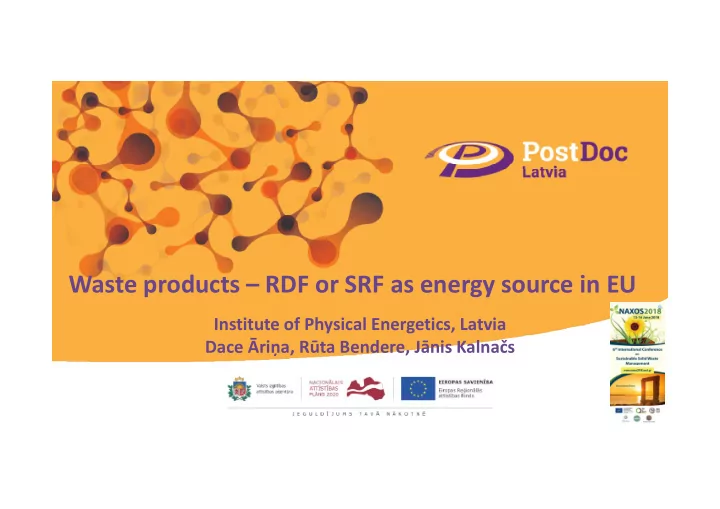

Waste products – RDF or SRF as energy source in EU Institute of Physical Energetics, Latvia Dace Ā ri ņ a, R ū ta Bendere, J ā nis Kalna č s
The target of the research to evaluate the mechanical pre-treatment of unsorted and partly sorted municipal solid waste by carrying out the analysis of waste composition and properties using different sorting lines in Latvia. The legislative proposals on waste: EU target for recycling 65% of municipal waste by 2030; EU target for recycling 75% of packaging waste by 2030; A binding landfill target to reduce landfill to maximum of 10% of municipal waste by 2030; A ban on landfilling of separately collected waste and main tools how to reach those targets.
Materials Flow 1 - Non-sorted municipal waste; Flow 2 - Partly sorted municipal waste – paper and plastics are separated at source; Flow 3 - Partly sorted municipal waste – biological waste (kitchen and green waste) is separated at source.
Methods and Materials Each selected truckload were weighed and the mass balance were established. A representative waste samples were taken with the grab method. The following parameters for Coarse fraction were determined using the Standards: moisture content – LVS EN 15414-3:2011; • net calorific value – LVS EN 15400:2011; • chlorine content – LVS EN 15408:2011; • sulphur content – LVS EN 15408:2011; • ash content – LVS EN 15403:2011; • content of trace elements (As, Ba, Be, Cd, Co, Cr, Cu, Hg, Mo, Mn, Ni, Pb, Sb, Se, Tl, V and Zn) – LVS EN • 15411:2012; content of major elements (Al, Ca, Fe, K, Mg, Na, P, Si, Ti) – LVS EN 15410:2012; • C, H, N content – LVS EN 15407:2011. • The energy content was measured using a bomb calorimeter Berthelot Mahler C.Co. The equipment used for elemental analysis was a Thermo Scientific FlashEA 1112. For metal analysis was used spectrometer CLR-7K’ XRF.
Three options of pre-treatment facilities for three Flows
Results – Composition of incoming municipal solid waste (mass, %) 60 50 40 30 % 20 10 0 Flow 1 Flow 2 Flow 3
Fractions of municipal solid waste after mechanical pre- treatment for flows 1-3 (mass %) Fractions Flow 1 Flow 2 Flow 3 After drum screener After disc screener After drum screener Coarse fraction 53 (>60 mm) 22 (>80 mm) 68 (>60 mm) Medium fraction - 40 (25-80 mm) - Fine fraction 45 (<60 mm) 35 (<25 mm) 30 (<60 mm) Metal 2 3 2 Reject material: 2.3% stones and ceramics; • 1.3 % food waste • Recyclables material: 10% glass; • 1.7% PET; • 4% cardboard; • 0.5% aluminium; • 0.6% metal; •
The mean values of the parameters of coarse fractions Coarse Moisture, NCV, MJ N, H, Ash, % Cl, % S, % C, % kg -1 Fractions % % % After drum 33 14 13 0.7 0.4 0.3 46 5.9 screener in Flow 1 After disc 35 15 13 0.95 0.2 0.2 50 7.1 screener in Flow 2 After drum 27 17 11 0.7 0.1 0.4 51 8.2 screener in Flow 3
Chemical content of ashes for coarse fractions Coarse fraction Coarse fraction Coarse fraction after drum after disc screener after drum screener Element Unit screener in Flow 1 in Flow 2 in Flow 3 mg kg -1 ≤ 0.4 ≤ 0.5 ≤ 0.1 Hg mg kg -1 0.7 0.8 0.1 Cd mg kg -1 ≤ 0.3 ≤ 0.3 ≤ 0.1 Tl M.-% 0.002 0.008 0.0001 Br M.-% ≤ 0.001 ≤ 0.0008 ≤ 0.0001 I mg kg -1 3 9 18 Sb mg kg -1 ≤ 0.4 ≤ 0.6 ≤ 0.2 As mg kg -1 24 13 19 Cr mg kg -1 7 6 2 Co mg kg -1 26 38 14 Cu mg kg -1 9 22 5 Pb mg kg -1 136 130 37 Mn mg kg -1 5 10 6 Ni mg kg -1 108 6 18 Sn mg kg -1 ≤ 13 ≤ 14 ≤ 10 V
Conclusions 1. The mean energetic parameters for pre-treated mechanically sorted coarse fraction in Flow 3 responds to limits stated for 3th class of SRF (EN15359) - Net calorific value is ≥ 15 MJ/kg; Chlorine is ≤ 1%; Mercury ≤ 0.08 Mg/MJ (Mediana) and ≤ 0.16 Mg/MJ (80th percentile). 2. Results showed that pre-shredding and screening of the wet non-sorted (Flow 1) or partly sorted (Flow 2) municipal solid waste by the equipment of waste separation do not ensure preparation of qualitative material for production of the fuel. 3. The biologically degradable waste separation at the source is necessary to lower moisture and ash content and higher heating value for potential fuel production from waste.
Thank You! dace.arina@gmail.com The research has been worked out by co-financial support of the European Regional Development Fund for postdoctoral project "Research of optical and energetic properties of mixed municipal solid waste material for its preparation for a recovery" No. 1.1.1.2/VIAA/1/16/221 (project agreement No. 1.1.1.2/16/I/001).
Recommend
More recommend